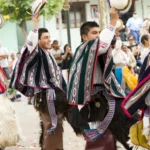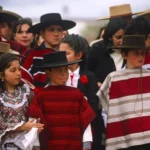Egypt, a land of ancient wonders and vibrant traditions, boasts a fascinating array of traditional clothing that reflects its rich history, diverse regions, and cultural influences. From the grandeur of pharaonic attire to the everyday garments worn in rural villages, Egyptian clothing tells a story of identity, artistry, and practicality.
Historical and Cultural Evolution of Egyptian Traditional Clothing
The history of Egyptian clothing spans millennia, shaped by ancient traditions, Islamic influences, and modern adaptations. Each period has contributed distinct elements that remain integral to Egypt’s cultural fabric.
Ancient Egyptian Garments
- 🌞 Linen as a Staple Fabric: Ancient Egyptians favored linen for its breathability, perfect for the hot climate.
- 👗 Kilts and Sheaths: Men wore kilts (shendyt), while women donned sheath dresses (kalasiris).
- 💎 Jewelry and Adornments: Gold and precious stones played a significant role, symbolizing wealth and spirituality.
- 🪶 Headpieces: Pharaohs and nobles often wore elaborately designed crowns or wigs.
Medieval and Islamic Influences
- 🕌 Galabeya: A loose-fitting robe for men and women, widely adopted for comfort and modesty.
- 🧕 Hijabs and Veils: Islamic traditions introduced headscarves and veils, which remain prominent in modern attire.
- 🧵 Intricate Embroidery: Traditional garments featured detailed patterns inspired by Islamic art and geometry.
Modern Adaptations
Contemporary Egyptian clothing blends traditional designs with global fashion influences, ensuring both practicality and cultural preservation.
Key Elements of Traditional Egyptian Clothing
For Women
- 🪡 Galabeya: Often adorned with vibrant patterns and embroidery.
- 🧣 Hijab: A staple for many Egyptian women, reflecting modesty and cultural identity.
- 💎 Traditional Jewelry: Necklaces, bracelets, and earrings made from gold or silver.
- 👗 Saidi Dresses: Worn in Upper Egypt, these dresses feature bold colors and intricate designs.
- 👡 Sandals: Open-toed footwear suitable for the hot climate.
For Men
- 👔 Galabeya: A versatile robe made from cotton or linen.
- 🩳 Kaftans: Loose robes worn over trousers in cooler regions.
- 🧢 Turbans: Commonly worn in rural and desert areas for sun protection.
- 👞 Leather Shoes: Durable and practical for various terrains.
- 🎩 Fez Hats: Historically associated with formal occasions.
Accessories and Craftsmanship
- Scarab Amulets: A symbol of protection and rebirth.
- Belts: Often used to cinch robes for a more tailored look.
- Handwoven Textiles: Crafted by artisans, reflecting regional patterns and techniques.
Regional Variations in Egyptian Traditional Clothing
Nile Delta
Women wear brightly colored galabeyas with floral patterns, while men favor simple white robes and turbans.
See also Traditional Clothing in Ecuador: A Tapestry of Heritage and Diversity
Traditional Clothing in Ecuador: A Tapestry of Heritage and Diversity
Cairo and Urban Areas
Urban clothing incorporates modern styles, with a preference for elegant and functional attire.
Upper Egypt (Saidi Region)
The Saidi galabeya is a hallmark of the region, featuring darker hues and bold embroidery.
Sinai Peninsula
Bedouin attire is distinctive, with heavily embroidered dresses for women and patterned headscarves for men.
Western Desert
Nomadic communities wear light, flowing garments to protect against the harsh desert climate.
See also Traditional Clothing in Chile: A Blend of Tradition and Identity
Traditional Clothing in Chile: A Blend of Tradition and Identity
Traditional Clothing in Egyptian Celebrations
Weddings
- 💍 Brides wear elaborate gowns, often blending traditional and modern designs.
- 🎉 Grooms may don a tailored suit or a finely embroidered galabeya.
- 💃 Guests often dress in vibrant, embellished clothing.
Religious Festivals
- 🌙 During Ramadan, traditional attire is common at family gatherings and mosque visits.
- 🕌 Eid celebrations feature colorful galabeyas and intricate jewelry.
Cultural Performances
Folk dances like Tanoura showcase colorful, layered skirts that swirl gracefully during performances.
Textiles and Techniques in Egyptian Clothing
Materials
- 🌾 Linen: An ancient staple, still prized for its lightweight texture.
- 🐑 Wool: Used in cooler regions and for winter garments.
- 🌸 Cotton: Egypt’s high-quality cotton is central to traditional and modern clothing.
Artisanal Techniques
- Weaving: Handloom textiles feature intricate patterns and vibrant colors.
- Embroidery: Regional motifs often depict flora, fauna, or geometric designs.
- Dyeing: Natural dyes derived from plants and minerals create rich, lasting colors.
Preserving and Reviving Traditional Egyptian Clothing
Artisan Support
- 🧵 Craft Cooperatives: Empowering local artisans to continue weaving and embroidery traditions.
- 🏛️ Museums: Institutions like the Egyptian Museum showcase historical attire and accessories.
Cultural Events
Festivals like Heritage Week celebrate Egypt’s traditional crafts and clothing.
Contemporary Fashion
Modern designers incorporate traditional elements, such as galabeya silhouettes and intricate embroidery, into high fashion.
A Timeless Elegance Rooted in History
Egypt’s traditional clothing serves as a bridge between its ancient legacy and contemporary identity. From the iconic galabeya to the opulent garments of the pharaohs, these clothes embody the nation’s resilience, artistry, and cultural pride. Whether seen in festivals, daily life, or international fashion, Egyptian attire continues to inspire and captivate the world.